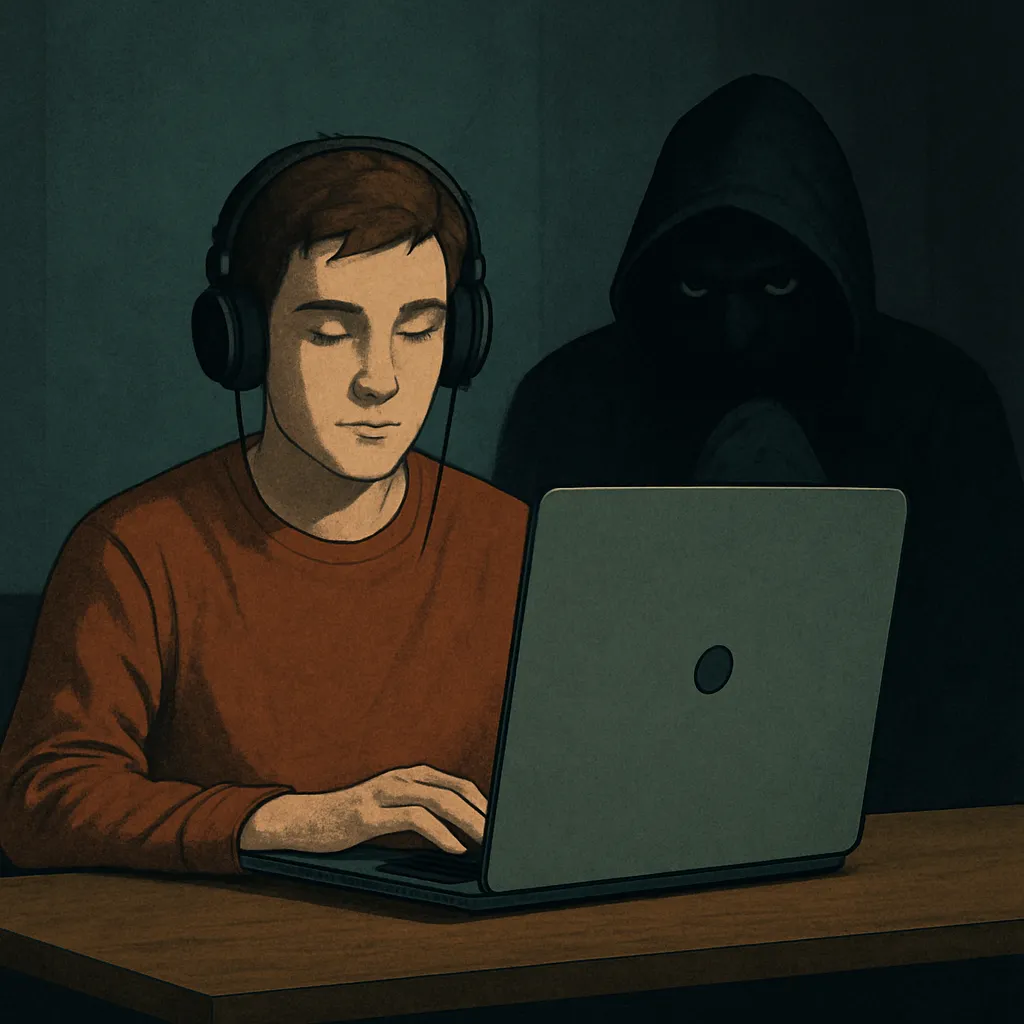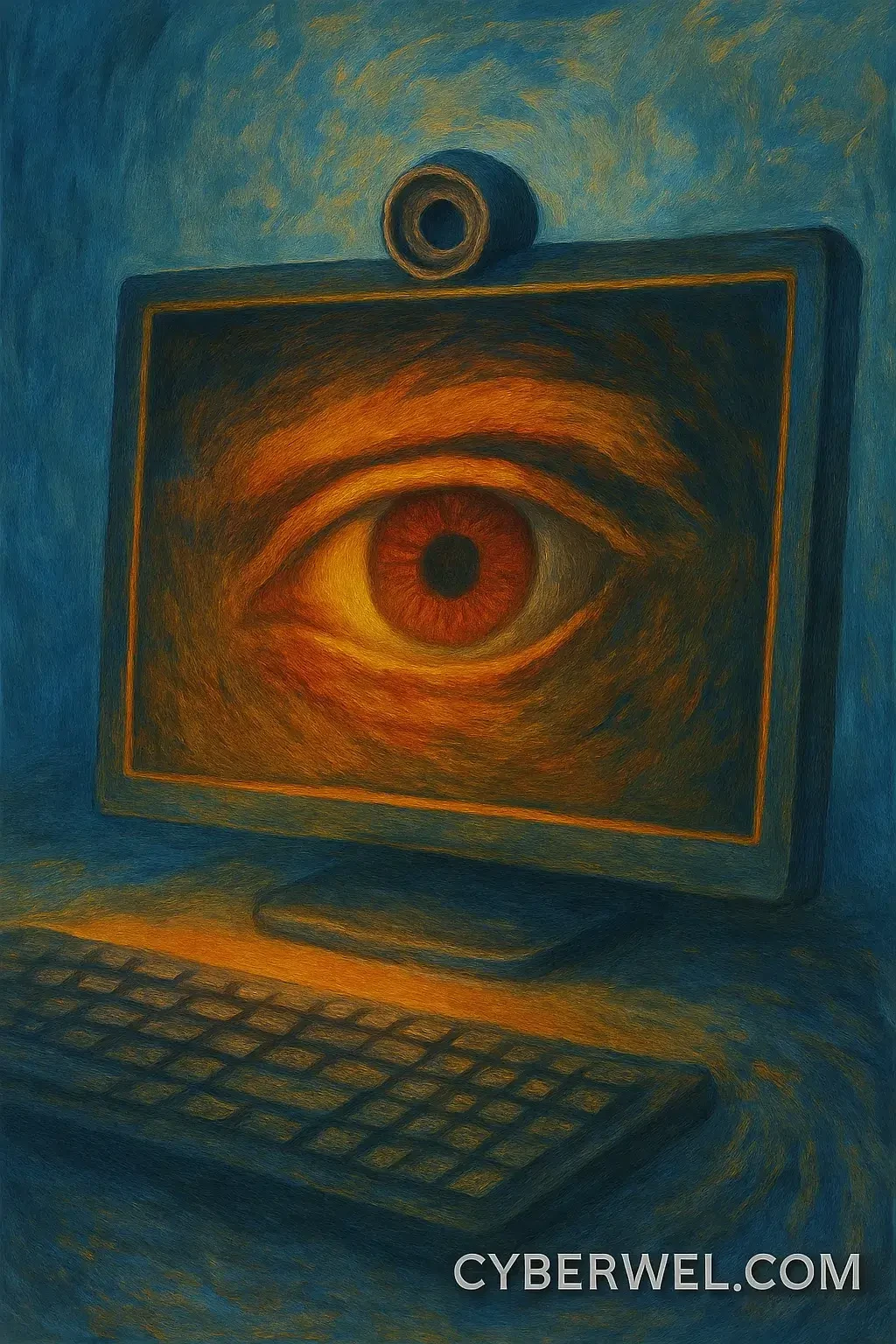⚠️ Disclaimer
This article is intended for educational and journalistic purposes only. It does not promote, instruct, or endorse any form of surveillance, malware use, or illegal activity. All tools, techniques, and cases mentioned are presented strictly to raise public awareness about digital privacy threats and help readers make informed, ethical decisions. The real-world examples include anonymized or reconstructed incidents based on confirmed tactics and expert analysis. Always comply with local laws and cybersecurity best practices.
“You don’t need a spy in the room anymore — the room itself is the spy.”
🧠 Introduction: The Eye in the Frame
You lean back in your chair after a long day. The screen glows, the room hums. You think you’re alone. But you’re not.
Above your monitor, a tiny glass lens stares back — always ready, always silent. It’s easy to forget it’s there. Until one day, it isn’t.
Once a simple communication tool, the webcam has quietly become the most underestimated spy in your home. It doesn’t need to break in. It’s already inside. Exploited by jealous lovers, rogue employers, digital voyeurs, and foreign intelligence units — your webcam is more than a tool. It’s a potential witness. A risk. A weapon.
This is not a thriller. This is your desk. Your laptop. Your living room.
This is the quiet war for your privacy — and how to survive it.

🎯 Part I: The History of a Hidden Threat
Webcam hacking isn’t new — but it’s never been this invisible or ubiquitous.
🕵️♂️ 2013 — The RAT Files
It was the year digital voyeurism went mainstream. Blackshades, a now-infamous Remote Access Trojan (RAT), was sold on underground forums for as little as $40. With it, thousands of amateur hackers — many barely out of high school — gained the ability to remotely control webcams, record videos, and even manipulate files without the user’s knowledge. The FBI eventually took down the operation, but not before more than half a million computers were silently compromised. Victims included teenage girls, journalists, and professionals, many of whom didn’t know they’d been watched until screenshots surfaced online.
🧨 2017 — DarkHotel & GhostRAT
The stakes escalated. No longer the domain of low-level hackers, webcam hijacking entered the world of espionage. State-backed groups like DarkHotel and those deploying GhostRAT began embedding webcam access into broader cyber-espionage toolkits. Hotel Wi-Fi networks in Asia were compromised, and high-value targets — business executives, diplomats, political dissidents — were unknowingly recorded in their rooms. These campaigns revealed how vulnerable modern infrastructure had become and how easily privacy could be weaponized.
💀 2020–2023 — Sextortion at Scale
By the early 2020s, webcam extortion evolved into an industrialized scheme. Telegram-based marketplaces began distributing “plug-and-play” malware kits capable of activating webcams, recording footage, and sending the data to remote operators. Victims received emails with screenshots and blackmail demands — often falsely accusing them of visiting adult sites, but sometimes with real video proof. This era blurred the line between scam and assault, creating psychological trauma for thousands. Amnesty International and Citizen Lab documented dozens of cases across North America and Europe, though experts say the true number is far higher.
🧬 2024–2025 — Silent Injection Attacks
In the past two years, the sophistication reached a chilling apex. Malware no longer needs to break down the front door — it slips through the cracks. Using virtual driver hooks and kernel-level injections, modern malware can hijack webcams without triggering antivirus alerts or even the indicator light. These attacks are often paired with supply chain exploits or firmware-level implants, making them almost impossible to detect. The result: cameras that look off, but aren’t. Threat intelligence groups — in confidential and open-source briefings — have warned about capabilities resembling these, especially in the context of APT frameworks — but public attribution remains limited.
🔥 Today, even air-gapped devices are vulnerable — if you’ve ever connected to Wi-Fi, you’ve opened the door. Cyber surveillance has become a background process in the operating system of modern life.
🕳️ Part II: Who’s Watching — and Why
Webcam surveillance is no longer a “hacker in a hoodie” myth. It’s a multi-pronged reality with different attackers — and disturbing motives.
| Actor | Goal | Example |
|---|---|---|
| 💔 Domestic abusers | Control, fear, surveillance | Spyware — as identified by digital rights groups like EFF and Citizen Lab |
| 🏢 Employers | Productivity, paranoia | Monitoring in remote desktop setups |
| 🐍 Extortionists | Blackmail, ransom | Sextortion scams using fake or real leaks |
| 🛰 State actors | Intelligence gathering | GhostNet, DarkHotel, Chinese APT groups |
| 👾 Script kiddies | Ego, thrill, experimentation | Open-source RATs on GitHub and Discord |
What was once a fringe phenomenon is now part of everyday digital abuse. In abusive relationships, webcam surveillance has become a digital leash. At work, monitoring software extends far beyond productivity — some tools now measure attention through eye contact and facial recognition. Meanwhile, nation-states exploit the same pathways to suppress dissent, spy on journalists, and even influence global policy negotiations.
“It’s not about the light on your camera. It’s about the code behind the scenes.”
🔬 Part III: How It Works (And Why You Don’t Know)
The scariest part of modern webcam hijacking? You’ll never see it coming.
1. Driver Hooking
Advanced malware interacts directly with device drivers to bypass operating system safeguards. The webcam light? Controlled by software. If the driver is hijacked, the light stays off — even when the feed is active. This method is frequently used in evolved RATs.
2. Virtual Webcam Emulation
According to forensic reports, some spyware creates a fake camera — a “virtual device” — that mirrors your real one. The user sees nothing wrong, but attackers receive a cloned stream. FinFisher and Predator have reportedly used this technique in targeted campaigns.
3. Process Masquerading
Webcam activity hides inside trusted system processes. A malicious DLL injects into something like svchost.exe or rdpclip.exe, making it nearly invisible to antivirus tools and end users. It’s digital camouflage.
4. Remote RAT Deployment
Stalkerware often disguises itself as parental control software. Once installed — whether through phishing, USB drops, or briefly unlocked devices — it grants complete webcam and microphone access. Many tools auto-sync footage to a remote cloud account.
In 2025, the camera doesn’t blink — and it doesn’t ask permission.
🧯 Part IV: Real-World Cases You Didn’t Hear About
🎓 Case 1: The Student Watched by His Own School
In 2023, a private U.S. school quietly installed remote monitoring software under the pretext of maintaining academic integrity. But the software didn’t just monitor screen activity — it had the ability to silently activate webcams. Students taking online tests from their bedrooms were recorded without consent. The case was never fully litigated, but it echoes previous scandals, like the 2010 Robbins v. Lower Merion School District lawsuit, where laptop cameras were used to monitor students at home. The psychological toll of such overreach is well-documented in privacy research.
💔 Case 2: Domestic Surveillance in Eastern Europe
A woman in Slovakia began to notice odd behaviors on her laptop — the webcam light flickering, strange battery drain. Though this particular incident remains anonymized in privacy watchdog reports, similar verified cases have emerged in Poland, Ukraine, and Romania. Stalkerware apps, often disguised as parental control software, remain poorly regulated in the region, making prosecution difficult. In many cases, victims discover surveillance only after consulting with independent IT specialists.
🏢 Case 3: Quiet Espionage at a Tech Startup
While this specific story is anonymized, similar surveillance patterns were observed in real-world incidents — including a 2022 Citizen Lab report documenting espionage through Zoom among Tibetan exile groups. Webcam behavior monitoring is now a standard concern in many corporate cybersecurity audits.
📺 Case 4: Smart TVs with Hidden Eyes
In 2021, a report from the German cybersecurity firm SEC Consult highlighted vulnerabilities in budget-brand smart TVs that allowed remote access to microphone and camera functions. While no manufacturer was named directly in follow-up briefings, advocacy groups pressured European regulators to enforce stricter firmware disclosure rules. This case inspired additional investigations in South Korea, where government-affiliated security labs confirmed that diagnostic firmware in some TVs could be remotely activated. While no legal charges were filed, researchers and consumer groups called for stricter transparency from manufacturers.
✒️ Editor’s Note: While some examples in this section are anonymized or based on patterns documented by researchers, all reflect real tactics observed in the field of webcam surveillance.
🛠️ Quick Audit: Is Your Webcam Safe?
- ☐ Is your camera light behaving oddly?
- ☐ Does your webcam app appear in Task Manager or Activity Monitor?
- ☐ Have you checked for unknown startup apps?
- ☐ Do you have a physical camera cover?
- ☐ Have you scanned for stalkerware in the last month?
🕵️ Part V: How to Tell If You’re Being Watched
| Sign | Possible Cause |
| 🔋 Laptop fans spin during idle | Video process running |
| 🧲 Camera light flashes randomly | Kernel-level hijack or virtual camera active |
| 💻 Unknown background processes | Look for wdhelper, vcam, rdpcom |
| 🌐 Outbound traffic to strange IPs | Use netstat or Wireshark for tracing |
| 📥 Sudden software installations | Especially disguised “screen sharing” tools |
🔐 Part VI: How to Protect Yourself
✅ 1. Use a Hardware Kill Switch or Webcam Cover
Even if malware takes control, the image will be blocked.
✅ 2. Audit Startup Processes Regularly
Tools like Autoruns (Windows) or launchctl list (macOS) can reveal hidden services.
✅ 3. Scan for RATs and Stalkerware
Trusted tools:
- Windows/Android: Malwarebytes, Hypatia
- iOS/macOS: Certo Scan, Lookout, iVerify
✅ 4. Disable Virtual Cameras in OS Settings
Remove suspicious drivers (e.g., “SnapCam”, “VCam”) via Device Manager or terminal commands.
✅ 5. Use Firewall Rules to Block Camera Access
Advanced users can sandbox apps or deny access to video I/O ports using third-party firewalls like Little Snitch or Portmaster.
📘 Glossary
| Term | Definition |
| RAT | Remote Access Trojan — full remote control of a system |
| Driver Hooking | Malware that intercepts hardware commands at kernel level |
| Stalkerware | Commercial spyware used for personal surveillance |
| Virtual Webcam | Fake camera device used to mirror or duplicate video |
| Process Masquerading | Malware hiding as legitimate system processes |
❓ FAQ
Q1: Can the webcam light be bypassed?
Yes. Sophisticated malware can suppress the indicator by hooking into driver or firmware layers.
Q2: Are MacBooks immune?
No, though they have better hardware-level protections. Malware has bypassed those in the past.
Q3: Will antivirus detect webcam malware?
Rarely. Most RATs use custom loaders or hide inside trusted processes. Deep behavioral scans work better.
Q4: Should I tape my webcam?
Yes, or use a mechanical cover. It’s low-tech, but effective — especially against stalkerware.
Q5: Is webcam surveillance legal?
Only with consent. Unauthorized access — even in domestic settings — is illegal in most jurisdictions, though enforcement lags behind technology.
🎬 Final Thought: The Eye That Never Blinks
In the era of silent surveillance, your devices don’t knock. They don’t blink. They don’t ask.
They listen.
They watch.
And they remember.
Your camera might be off.
But someone else might have left it on.
📚 Sources & Further Reading
- Amnesty International — Sextortion and spyware reports, 2022–2024
- Citizen Lab — Investigations into FinFisher, Predator, and Zoom espionage
- EFF (Electronic Frontier Foundation) — Guides on stalkerware and digital rights
- SEC Consult — Smart TV Firmware Vulnerabilities Report, 2021
- Kaspersky — 2024 Webcam Threats & Stalkerware Statistics
- Robbins v. Lower Merion School District — Case summary on school surveillance
- FireEye/Mandiant — DarkHotel & GhostRAT APT analysis
- Lookout Security — Mobile RAT and stalkerware threat models
All external links are current as of July 2025 and provided for further public education.
